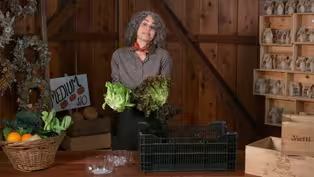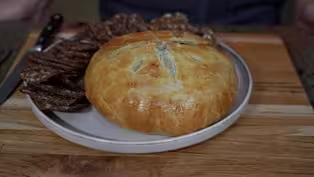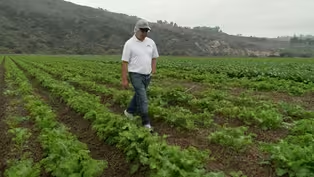
Freight Farms
Clip: 8/23/2024 | 5m 21sVideo has Closed Captions
A school district grows hydroponic lettuce for its students inside a converted shipping container.
Discover how this Bay Area school district is growing lettuce for its salad bars using hydroponic technology inside a converted shipping container - right on campus!
Problems playing video? | Closed Captioning Feedback
Problems playing video? | Closed Captioning Feedback
America's Heartland is presented by your local public television station.
Funding for America’s Heartland is provided by US Soy, Sustainable Agriculture Research and Education, Rural Development Partners, and a Specialty Crop Grant from the California Department of Food and Agriculture.

Freight Farms
Clip: 8/23/2024 | 5m 21sVideo has Closed Captions
Discover how this Bay Area school district is growing lettuce for its salad bars using hydroponic technology inside a converted shipping container - right on campus!
Problems playing video? | Closed Captioning Feedback
How to Watch America's Heartland
America's Heartland is available to stream on pbs.org and the free PBS App, available on iPhone, Apple TV, Android TV, Android smartphones, Amazon Fire TV, Amazon Fire Tablet, Roku, Samsung Smart TV, and Vizio.
Providing Support for PBS.org
Learn Moreabout PBS online sponsorship(gentle music) - Providing students with real fresh-grown, nutrient-dense produce is real pivotal to the learning.
- [Narrator] Michael Jochner admits it's a very unusual way to farm, but says that technology and this shipping container are key to meeting the green salad lettuce needs for students in the Morgan Hill Unified School District.
- Well, I think food sovereignty is important, especially in underserved communities.
And I wanted to demonstrate that a school district and not just large farming or small-scale farming, that a school district itself could be the farm.
- [Narrator] Michael has a background as a chef and is Morgan Hill's director of Student Nutrition.
The shipping container is called a Freight Farm and uses the vertical hydroponic farming technology developed by a Boston company.
It all takes place in a 10-by-40 foot space.
- So let me show you our nursery station.
This is where the lettuce and the seedlings start their life cycle.
The nursery station is kind of the brains of the Freight Farm operation.
All of our nutrients are stored here.
The computer pumps continually check the water, evaluate the EC readings, pH readings, temperature readings, and then at the end of the nursery station, we have a 40 gallon reservoir where all that water is stored.
- [Narrator] Michael grows five varieties of lettuce which germinate at the nursery station in small grow pods.
Nutrient-dense water feeds the roots of the tiny plants.
- Down on this floor, we start our seeds in the grow pods.
They'll spend two weeks in the humidity domes, and at the end of the two-week cycle, they turn into these beautiful little seedlings.
- [Narrator] The Freight Farm at Sobrato High School is one of two in the district, each costing $150,000.
After sprouting, the seedlings move to vertical-growing panels called cultivation walls watered with drip irrigation.
Each farm container will grow 4,000 small heads of lettuce at a time.
LED light walls powered by the high school's solar panels provide the illumination for plant growth.
- So leafy greens require specific light spectrum.
Freight Farm uses red and blue lights in the cultivation walls.
This is our daylight setting.
We have over 100,000 LED lights, and these lights will remain on for 14 hours of simulated sunlight.
As the lettuce transitions from seedling to full head, the full-head lettuce requires a different light spectrum for healthy lettuce leaf growth.
This helps promote healthy root growth and healthy, strong, crispy lettuce that our students really seem to enjoy.
So lettuce on this wall is now six weeks old.
Morgan Hill students get to enjoy living lettuce right from our walls.
We take the lettuce from the wall, and unlike conventional farming where you have to bend over, we simply lift the panel off the wall, and we transfer the panel right to our nursery station.
- [Narrator] Lettuce from the cultivation panels goes directly to lunch rooms and cafeteria salad bars.
Michael says the container farms produce the equivalent of 2 1/2 acres of lettuce in just 320 square feet of grow space.
Raising their own has also helped the district reduce part of their spending on fresh produce.
For second-graders Aida and Cody, it means a tasty part of their daily choices at lunch.
- I always love salads.
I had tomatoes, salad, ranch, cucumbers, and plums.
- For a lot of our students, it's the only meal that they have during the day, and so we take our school nutrition efforts very seriously to ensure that our students are eating healthy.
- My dream is to ultimately try and grow the whole salad bar.
While ambitious, we decided to start with lettuce because the technology allowed us to do so.
- [Narrator] Michael calls his future agricultural plans farm tech.
It would utilize existing greenhouse facilities and the district's open space to develop curriculums and coursework.
Both would emphasize the nutritional and environmental benefits of merging technology and farming.
- The district is sitting on several acres of land that has been set aside to see if we can build farm tech into a destination-worthy, field trip-worthy location for both students and the community.
I'd like to show off the technology and show that its importance in a community is not solely reliant on conventional farming, that there are high-tech alternatives.
- [Narrator] But for now, the technology is providing daily evidence of the possibilities that come from finding new ways to help feed students and the community.
- For me, it's really just been about the kids and watching them grow to learn real produce.
- If we begin with our students and teach our students the importance of healthy eating habits, those habits will stay with them throughout their entire lives, and it will pay dividends to ensure that our kids grow a healthy life.
(students chattering)
Hydroponic Farming - Harvesting Health
Video has Closed Captions
Clip: 8/23/2024 | 5m 24s | Our health expert explores the nutritional differences between hydroponic and conventional farming. (5m 24s)
Mushroom Brie - Farm to Fork by Sharon Profis
Video has Closed Captions
Clip: 8/23/2024 | 5m 22s | Learn how to make a mushroom brie wrapped in a puffed pastry. (5m 22s)
Video has Closed Captions
Clip: 8/23/2024 | 5m 21s | A farm family meets the increasing consumer demand for washed and bagged salads. (5m 21s)
Providing Support for PBS.org
Learn Moreabout PBS online sponsorship
- Food
Lidia Celebrates America
Lidia Bastianich honors America’s volunteers, revealing how giving back unites and uplifts.













Support for PBS provided by:
America's Heartland is presented by your local public television station.
Funding for America’s Heartland is provided by US Soy, Sustainable Agriculture Research and Education, Rural Development Partners, and a Specialty Crop Grant from the California Department of Food and Agriculture.



